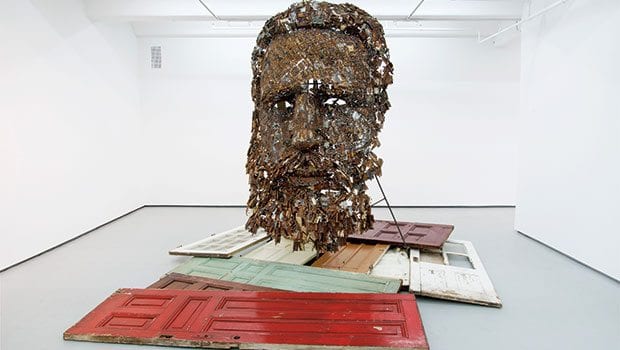
The Peabody Essex Museum has on display a recently acquired sculpture by Cuban artist Yoan Capote. “Immanence,” a massive 10-foot-tall representation of Fidel Castro, on display through Nov. 19, brings a political and cultural meditation to the museum. “The core of the Peabody Essex is the idea of cultural intersection,” says Trevor Smith, curator of the museum’s Present Tense contemporary initiative. “This piece is a perfect example of that.”
On the Web
To learn more about the acquisition and the Peabody Essex Museum, visit: www.pem.org.
For more information about Yoan Capote, visit: www.yoan-capote.com/en
Though at first sight the sculpture represents a controversial leader, a closer look tells a very different story. The piece is constructed with thousands of rusted door hinges. The Havana-based Capote would bring bags of new hinges back from America and trade with his neighbors and acquaintances for their old ones. In this way, the artist gathered materials while also supporting his community.
The hinges bear a dual representation. First, they represent the common people that they came from. “Fundamentally, it’s a collective portrait of the people,” says Smith. “A lot of Capote’s work reinforces the power of collective action.” It also represents access. The hinge, though only a small part of a door, controls what is closed or open, public or private. Similarly, Castro controlled what the public saw and knew through propaganda. The two symbolic meanings convey a tension between power and people.
Beneath the hinge-head sculpture lies a pile of discarded doors. Without the hinges to move them, what are these wood pieces worth? Without the support of the people, who has the power, really?
The idea of collective actions pertains to the current American political sphere. Here in Massachusetts, collective peaceful public protests and marches are a favored avenue of political resistance.
Capote works in many media, from sculpture and installation to photography and video. The scale of this piece resonated with the museum group while touring Capote’s studio, Smith said. Smith had the sculpture installed in the East India Marine Hall, an iconic room in the museum, often used for functions and weddings. The room’s walls are lined with figureheads from ships and its large windows look out into Salem.
This heavily historic, New England-themed room provides an interesting contrast to the contemporary Cuban work. It prompts viewers to compare and contrast their own situation with the concepts the sculpture represents. Smith notes also that the versatility of the piece shines here. At such a large scale, the bearded figure could be Poseidon, or Socrates, just as easily as Castro.
“Immanence” encourages discourse above all. “There’s a universality to it,” says Smith. “It’s a portrait of power, but it’s up to the audience whose power it is.”




![Banner [Virtual] Art Gallery](https://baystatebanner.com/wp-content/uploads/2024/04/NJ-H_1-713x848.jpg)

